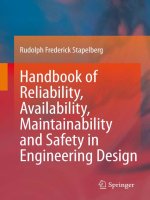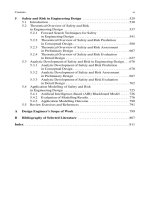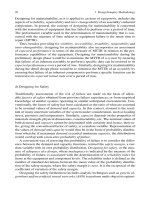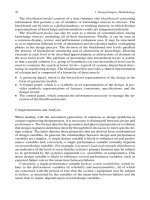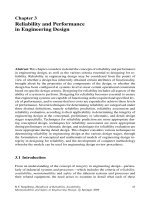Handbook of Reliability, Availability, Maintainability and Safety in Engineering Design - Part 1 docx
Bạn đang xem bản rút gọn của tài liệu. Xem và tải ngay bản đầy đủ của tài liệu tại đây (101.25 KB, 10 trang )
Handbook of Reliability, Availability,
Maintainability and Safety in Engineering Design
Rudolph Frederick Stapelberg
Handbook of Reliability,
Availability, Maintainability
and Safety in Engineering
Design
123
Rudolph Frederick S tapelberg, BScEng, MBA, PhD, DBA, PrEng
Adjunct Professor
Centre for Infrastructure and Engineering Management
Griffith University
Gold Coast Campus
Queensland
Australia
ISBN 978-1-84800-174-9
DOI 10.1007/978-1-84800-175-6
e-ISBN 978-1-84800-175-6
British Library Cataloguing in Publication Data
Stapelberg, Rudolph Frederick
Handbook of reliability, av ailability, maintainability and
safety in engineering design
1. Reliability (Engineering) 2. Maintainability
(Engineering) 3. Industrial safety
I. Title
620’.0045
ISBN-13: 9781848001749
Library of Congress C ontrol Number: 2009921445
c
2009 Springer-Verlag London Limited
Apart from any fair dealing for the purposes of research or private study, or criticism or revie w, as per-
mitted under the Copyright, Designs and Patents Act 1988, this publication may only be reproduced,
stored or transmitted, in any form or by any means, with the prior permission in writing of the publish-
ers, or in the case of reprographic reproduction in accordance with the terms of licences issued by the
Copyright Licensing Agency. Enquiries concerning reproduction outside those terms should be sent to
the publishers.
The use of registered names, trademarks, etc. in this publication does not imply, even in the absence of
a specific statement, that such names are ex empt from the relevant laws and regulations and therefore
free for general use.
The publisher mak es no representation, express or implied, with regard to the accuracy of the information
contained in this book and cannot accept any legal responsibility or liability for any errors or omissions
that may be made.
Cover design: eStudio Calamar S.L., Girona, Spain
Printed on acid-free paper
987654321
springer.com
Preface
In the past two decades, industry—particularly the process industry—has witnessed
the development of several large ‘super-projects’ , most in excess of a billion dol-
lars. These large super-projects include the exploitation of mineral resources such
as alumina, copper, iron, nickel, uranium and zinc, through the construction o f huge
complex industrial process plants. Although these super-projects create many thou-
sands of jobs resulting in a significant decrease in unemployment, especially during
construction, as well as projected increases in the wealth and growth of the econ-
omy, they bear a high risk in achieving th eir forecast profitability through maintain-
ing budgeted costs. Most of the super-projects have either exceeded their budgeted
establishment costs or have experienced operational costs far in excess of what was
originally estimated in their feasibility prospectus scope. This has been the case not
only with projects in the process industry but also with the development of infras-
tructure and high-technology projects in the petroleum and defence industries. The
more significant contributors to the cost ‘blow-outs’ experienced by these projects
can be attributed to the complexity of their engineering design, both in technology
and in the complex integration of systems. These systems on their own are usually
adequately designed and constructed, often on the basis of previous similar, though
smaller designs.
It is the critical combination and complex integration of many such system s that
give rise to design complexity and consequent frequent failure, where high risks
of the integrity of engineering design are encountered. Research into this problem
has indicated that large, expensive engineering projects may have quite superficial
design reviews. As an essential control activity of engineering design, design re-
view practices can take many forms. At the lowest level, they consist merely of
an examination of engineering drawings and specifications before construction be-
gins. At the highest level, they consist of comprehensive evaluations to ensure due
diligence. Design reviews are included at d ifferent phases of the engineering design
process, such as conceptual design, preliminary or schematic design, and final detail
design. In most cases, though, a structured basis of measure is rarely used against
which designs, or design alternatives, should be reviewed. It is obvious from many
v
vi Preface
examples of engineered installations that most of the problems stem from a lack of
proper evaluation of their engineering integrity.
In determining the complexity and consequent frequent failure of the critical
combination and complex integration of large engineering processes and systems,
both in their level of technology as well as in their integration, the integrity of
their d esign needs to be determined. This includes reliability, availability, main-
tainability and safety of the inherent process and system functions and their re-
lated equipment. Determining engineering design integrity implies determining re-
liability, availability, maintainability and safety design criteria of the design’s in-
herent systems and related equipment. The tools that most design engineers re-
sort to in determining integrity of design are techniques such as hazardous oper-
ations (HazOp) studies, and simulation. Less frequently used techniques include
hazards analysis (HazAn), fault-tree analysis, failure modes and effects analysis
(FMEA) and failure modes effects and criticality analysis (FMECA). Despite the
vast amount of research already conducted, many of these techniques are either
misunderstood or conducted incorrectly, or not even conducted at all, with the result
that many high-cost super-projects eventually reach the construction phase without
having been subjected to a rigorous and correct evaluation of the integrity of their
designs.
Much consideration is being given to general engineering d esign, based on the
theoretical expertise and practical experience of chemical, civil, electrical, elec-
tronic, industrial, mechanical and process engineers, from the point of view of ‘ what
should be achieved’ to meet the design criteria. Unfortunately, it is ap parent that not
enough consideration is being given to ‘what should be assured’ in the event the
design criteria are not met. It is thus on this basis that many high-cost super-projects
eventually reach the construction phase without having been subjected to a proper
rigorous evaluation of the integrity of their designs. Consequently, research into
a m ethodology for determining the integrity of engineering design has been initi-
ated by the contention that not enough consideration is being given, in engineering
design and design reviews, to what should be assured in the event of design cri-
teria not being met. Many of the methods covered in this handbook have already
been thoroughly explored by other researchers in the fields of reliability, avail-
ability, maintainability and safety analyses. What makes this compilation unique,
though, is the combination of these methods and techniques in probability and pos-
sibility modelling, mathematical algorithmic modelling, evolutionary alg orithmic
modelling, symbolic logic modelling, artificial intelligence modelling, and object
oriented computer modelling, in a logically structured approach to determining the
integrity of engineering design.
This endeavour has encompassed not only a depth of research into the various
methods and techniques—ranging from quantitative probability theory and expert
judgement in Bayesian analysis, to qualitative possibility theory, fuzzy logic and un-
certainty in Markov analysis, and from reliability block diagrams, fault trees, event
trees and cause-consequence diagrams, to Petri nets, genetic algorithms and artifi-
cial neural networks—but also a breadth of research into the concept of integrity
Preface vii
in engineering design. Such breadth is represented by the topics of reliability and
perfor mance, availability and maintainability, and safety and risk, in an overall con-
cept of designing for integrity during the engineering design process. These topics
cover the integrity of engineering design not only for complex industrial processes
and engineered installations but also for a wide range of engineering systems, from
mobile to installed equipment.
This handbook is therefore written in the best way possible to appeal to:
1. Engineering design lecturers, for a comprehensive coverage of the subject the-
ory and application examples, sufficient for addition to university graduate and
postgraduate award courses.
2. Design engineering students, for sufficient theoretical coverage of the different
topics with insightful examples and exercises.
3. Postgraduate research candidates, for use of the handbook as overall guidance
and reference to other material.
4. Practicing engineers who want an easy readable reference to both theoretical
and practical applications of the various topics.
5. Corporate organisations and companies (manufacturing, mining, engineering
and process industries) requiring standard approaches to be understood and
adopted throughout by their technical staff.
6. Design engineers, design organisationsandconsultant groups who requirea ‘best
practice’ handbook on the integrity of engineering design practice.
The topics covered in this handbook have proven to be much more of a research
challenge than initially expected. T he concept of design is both complex and
complicated—even more so with engineering design, especially the design of en-
gineering systems and processes that encompass all o f the engineering disciplines.
The challenge has been further compounded by focusing on applied and current
methodology for determining the integrity of engineering design. Acknowledge-
ment is thus gratefully given to those numerous authors whose techniques are pre-
sented in this handbook and also to those academics whose theoretical insight and
critique made this handbook possible. The proof of the challenge, however, was
not only to find solutions to the integrity problem in engineering design but also
to be able to deliver some means of implementing these solutions in a practical
computational format. This demanded an in-depth application of very many sub-
jects r anging from mathematical and statistical modelling to symbolic and compu-
tational modelling, resulting in the need for research beyond the basic engineering
sciences. Additionally, the solution models had to be tested in those very same en-
gineering environments in wh ich design integrity problems were highlighted. N o
one looks kindly upon criticism, especially with regard to allegations of shortcom-
ings in their profession, where a high level of resistance to change is inevitable
in respect of implementing new design tools such as AI-based blackboard mod-
els incorporating collaborative expert systems. Acknowledgement is therefore also
gratefully given to those captains of industry who allowed this research to be
viii Preface
conducted in their companies, including all those design engineers who offered so
much of their valuable time. Last but by no means least was the support and encour-
agement from my wife and family over the many years during which the topics in
this handbook were researched and accumulated from a lifetime career in consulting
engineering.
Rudolph Frederick Stapelberg
Contents
Part I Engineering Design Integrity Overview
1 Design Integrity Methodology 3
1.1 DesigningforIntegrity 4
1.1.1 DevelopmentandScopeofDesignIntegrityTheory 12
1.1.2 Designing for Reliability, Availability, Maintainability
andSafety 14
1.2 Artificial Intelligence in Design . 21
1.2.1 Development of Models and AIB Methodology . 22
1.2.2 Artificial Intelligence in Engin eering Design . . 25
2 Design Integrity and Automation 33
2.1 Industry Perception and Related Research . 34
2.1.1 Industry Perception . . . 34
2.1.2 RelatedResearch 35
2.2 Intelligent Design Systems 37
2.2.1 The Future of Intelligent Design Systems 37
2.2.2 Design Automation and Evaluation Design Automation . . . . 3 8
Part II Engineering Design Integrity Application
3 Reliability and Performance in Engineering Design 43
3.1 Introduction . . 43
3.2 Theoretical Overview of Reliability and Perf ormance
inEngineeringDesign 45
3.2.1 Theoretical Overview of Reliability and Perfo rmance
PredictioninConceptualDesign 60
3.2.2 Theoretical Overview of Reliability Assessment
inPreliminaryDesign 72
3.2.3 Theoretical Overview of Reliability Evalu a tion
inDetailDesign 90
ix
x Contents
3.3 Analytic Develo pment of Reliability and Performance
inEngineeringDesign 107
3.3.1 Analytic Develop ment of Reliability
andPerformancePredictioninConceptualDesign 107
3.3.2 Analytic Development of Reliability Assessment
inPreliminaryDesign 133
3.3.3 Analytic Development of Reliability Evaluation
inDetailDesign 190
3.4 Application Modelling of Reliability and Performance
inEngineeringDesign 241
3.4.1 TheRAMSAnalysisApplicationModel 242
3.4.2 Evaluation of Modelling Results. . 271
3.4.3 Application Modelling Outcome . 285
3.5 ReviewExercisesandReferences 288
4 Ava ilability and Maintainability in Engineering Design 295
4.1 Introduction 296
4.2 Theoretical Overview of Availability and Maintainability
inEngineeringDesign 302
4.2.1 Theoretical Overview of Availability and Maintainability
PredictioninConceptualDesign 308
4.2.2 Theoretical Overview of Availability and Maintainability
AssessmentinPreliminaryDesign 349
4.2.3 Theoretical Overview of Availability and Maintainability
EvaluationinDetailDesign 385
4.3 Analytic Development of Availability and Maintainability
inEngineeringDesign 415
4.3.1 Analytic Development of Availability and Maintainability
PredictioninConceptualDesign 416
4.3.2 Analytic Development of Availability and Maintainability
AssessmentinPreliminaryDesign 436
4.3.3 Analytic Development of Availability and Maintainability
EvaluationinDetailDesign 456
4.4 Application Modelling of Availability and Maintainability
inEngineeringDesign 486
4.4.1 ProcessEquipmentModels(PEMs) 486
4.4.2 Evaluation of Modelling Results. . 500
4.4.3 Application Modelling Outcome . 518
4.5 ReviewExercisesandReferences 520

